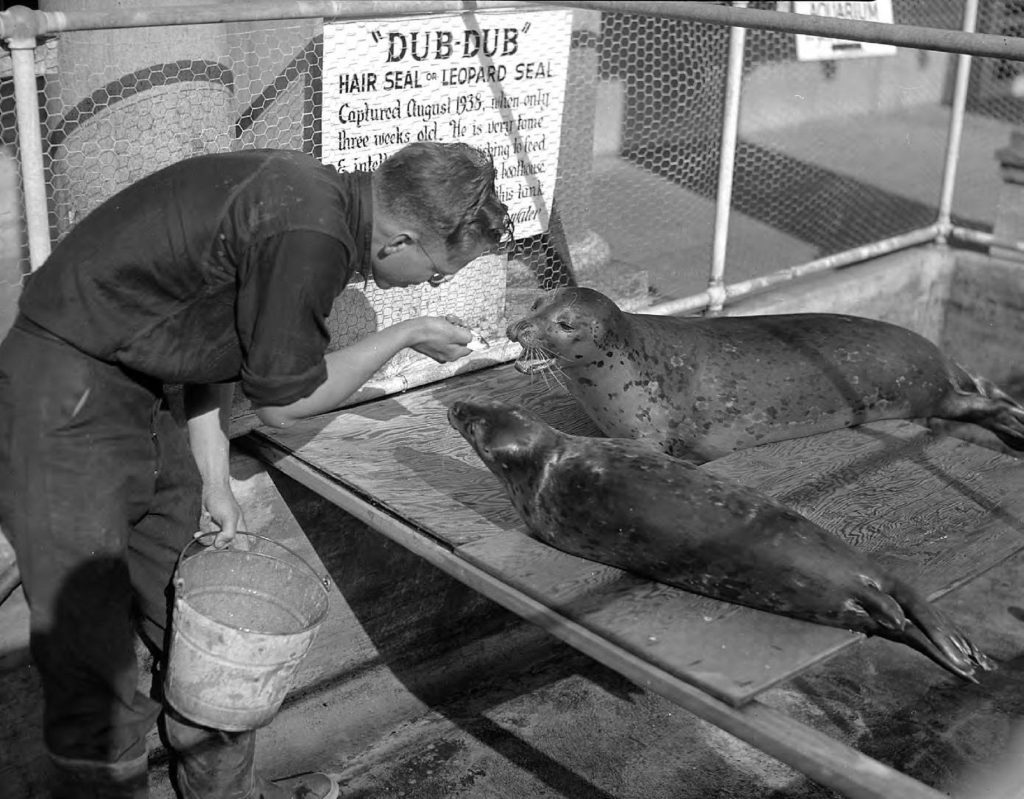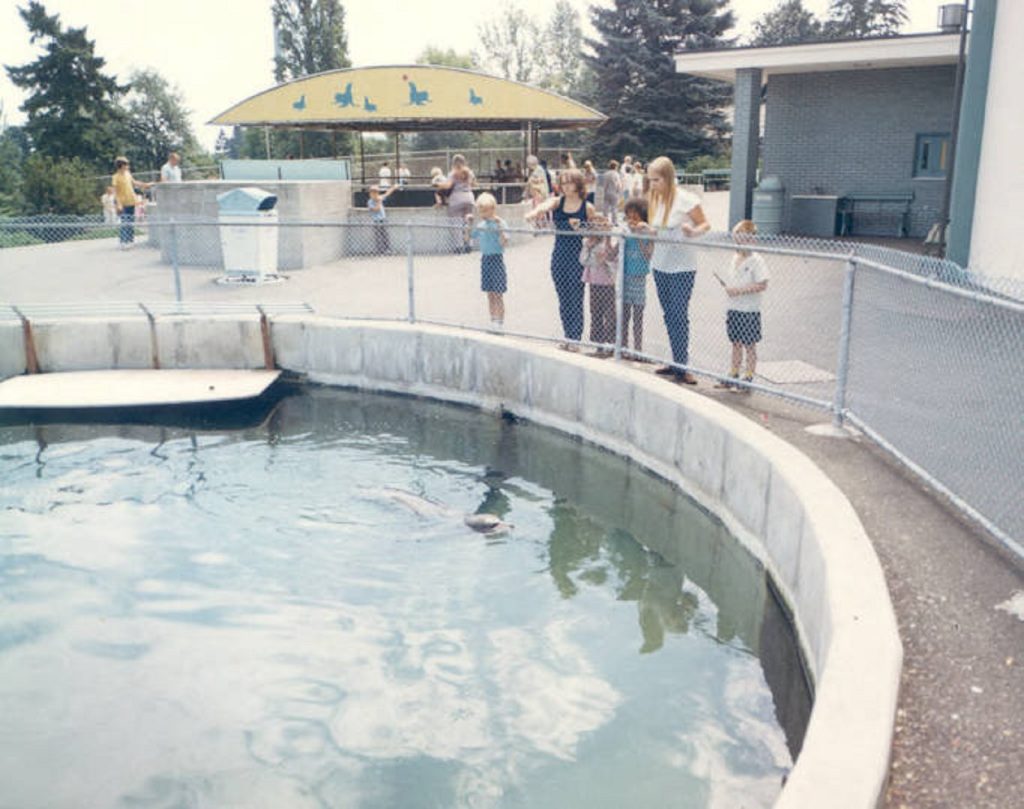From 1938 to 1972, Point Defiance Aquarium’s star attraction was a harbor seal. Named Dub Dub, he helped the aquarium by charming children and adults alike through the years of his long life.
Pup Days at Point Defiance Aquarium
Harbor seals live on the Pacific Coast from northern Baja California to the Gulf of Alaska and Bering Sea. During the early 20th century, their numbers were decimated by a state-funded “population control” program that paid hunters bounties. This program ended in 1960, and seals were protected under the federal Marine Mammal Protection Act in 1972.

On July 29, 1938, police got reports of a baby crying at Boston Harbor near Olympia. But when Lester Darling took his sailboat “Gavenka” to look for the lost child, he found a three-week-old orphan seal clinging to a piling instead. The seal was taken to the Point Defiance Aquarium.
At the time, the aquarium was a small group of saltwater tanks at the waterfront pavilion. Founded in 1935, the place was not making money. All of that changed, it was later claimed, because of Dub Dub, the orphan seal.
People eagerly paid to see the “new park pet,” as the newspapers called the seal. With his tank just outside the aquarium, he attracted people in to see the rest. Aquarist Wilhelm Jordan raised the seal in a wooden tub, feeding it milk and ground fish and teaching it to swim as a mother seal would. Soon, the seal was going “after fish like a streak.”
The seal was named in early August when a visiting child exclaimed, “Dub Dub!” looking at the animal. Jordan, assuming it was from the tub the animal was in, liked the name because it was not human. “Anything,” he said, “could be called Dub Dub.” In 1962, Sherry Lee Adler Pirak claimed she had named the seal. Her mother told the News Tribune that she doubted her then-toddler had named the seal for his tub, as she had also called the ducks “Din Din.”

Dub Dub, Tacoma’s Citizen of the Year?
Dub Dub was an instant sensation. Early accounts mistakenly called the seal a girl, but it was soon realized it was a boy. People bought live herring from the bait shop to feed him. This practice continued for years, as the aquarium could not afford to adequately feed its animals. In 1942, the Tacoma News Tribune even joked about nominating Dub Dub for “Citizen of the Year” someday.
Dub Dub moved to a slightly bigger concrete tank, and in the summer of 1939, he was joined by Fifi, a female seal. She died in 1940, Dub Dub mourning by her side. Other seals joined him over the years, but Dub Dub was the undisputed ruler of the pool. By 1940, he was getting a little chubby and would nap on a platform above the pool from 1 to 3 in the afternoon. Jordan could not wake him up to entertain the crowds.
Dub Dub found love with Celia in 1946. Blinded by hunters on Skagit Flats, she kept close to him.

Long-Lived Seal Gets a New Home
Dub Dub outlived most of his fellow seals, including Celia. Harbor seals live an average of 18 years, but Dub Dub showed no signs of giving up the ghost. U.S. Fish and Wildlife biologists were interested in studying him after his death, but he outlasted multiple scientists’ careers.
In 1953, the seals moved to a bigger open-air “seal-arium” tank a few feet from their current place. Twenty feet long, it was located in front of the aquarium box office. While the other seals were carried over in trash cans, Dub Dub was allowed to waddle over on a ramp.
In the 1960s, Dub Dub got a newer and better home when the park built a new aquarium. Brosseau went before the park commission to argue that Dub Dub needed his own tank, lest the younger male seals gang up on him or the shock of the move prove too much. It could later be repurposed for porpoises. While some commissioners grumbled about paying thousands for an “old folks home for Dub Dub,” the board approved the measure.
Opening in 1964, Dub Dub enjoyed his new $9,500 home just outside the front entrance of the new aquarium. He almost had to relearn to tread water, confused by the new space. While his old tank had been a mere three feet deep, the new pool was nine feet deep and 30 feet across with 50,000 gallons of water. Dub Dub thrived, losing some of his stiffness. To everyone’s shock, he even fathered a pup with Babe the following year, but his only child was stillborn.

Dub Dub’s Final Years and Legacy
Dub Dub remained famous, the “celebrity seal” who ruled the pool. “The News Tribune did an unforgivable thing this year,” the paper remarked in October 1964. “It let Dub Dub’s’ birthday pass unnoticed…” But “Dub Dub The Great, father of world sealdom” was getting old. He managed to beat a bout with stomach ulcers but suffered from baldness, arthritis, worn teeth and eventually went deaf and blind.
On February 24, 1972, Dub Dub was found dead in his pool. He was 33. “A joyful bark is stilled,” mourned the News Tribune. In 1986, a statue of the seal was installed at the aquarium, “The House that Dub Dub Built,” as Brosseau once called it.
Many residents still remember the old seal fondly. Although Dub Dub had no descendants, he charmed countless children. “He must have doused a half million people,” Cecil Brousseau once said. “But I never got one complaint.”




































